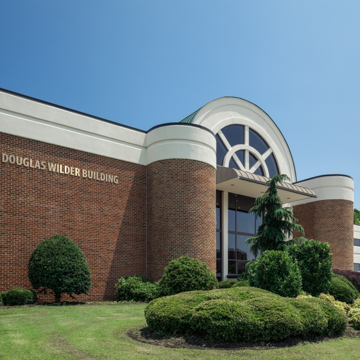You are here
Virginia State University
Chartered as Virginia Normal and Collegiate Institute—the part of William Mahone's Readjuster platform to establish more educational opportunities for Virginia's students—VSU is one of the oldest state-supported African American institutions of higher education in the United States and one of two land grant colleges in Virginia. Set on a lovely bluff above the Appomattox River, the university's many brick buildings are laid out in an irregular pattern with most of the earlier structures located at the south end of the campus. Although no longer standing, the college's first building, Virginia Hall (1888; demolished 1937), was an enormous Second Empire brick building designed by Harrison Waite of Petersburg. Waite was also the architect of the oldest extant building on campus, Vawter Hall (1908; later modifications), a two-and-a-half-story H-shaped structure with corbeled brick cornices. The building's elbowed gable parapets are echoed in the elbowed parapets of the single dormers centered on each long elevation. Three of the building's original wooden Doric porches survive. The adjacent former President's House (now Storum Hall, 1913) designed by Samuel Daley Craig of Petersburg is a two-story, hipped-roof brick building that has been modified, including the addition of a bay and the enclosure of a porch.
Virginia's leading collegiate architect of the era, Charles M. Robinson of Richmond, designed many edifices between 1920 and 1930. His Georgian Revival brick dormitories line the north side of Hayden Street--the women's dormitories were separated from the men's to the west by College Avenue. One of the men's dormitories, Williams Hall (1934), is credited to John Binford Walford of Richmond, who joined Robinson's office in 1918 and probably helped design some of the buildings attributed to Robinson. Of the several buildings Walford designed, his most distinguished is the second Virginia Hall (1937), the principal building on the campus. The seven-bay central block of this three-and-a-half-story brick building with a full-height pedimented Doric entrance portico is framed by three-bay pedimented end pavilions. Rising from the hipped roof is a multitiered cupola. All of the buildings attributed to Robinson and Walford are in a restrained Georgian Revival that blends well with the many newer campus buildings, which are almost universally brick.
The L. Douglas Wilder Building (1997, Ben R. Johns Jr.) is named for the nation's first elected African American governor. Entrance to its barrel-vaulted central hall is through double doors set in a two-story central section below a giant stylized fanlight. Gently rounded brick projections sandwich the glazed center and are in turn flanked by long rectilinear wings—solid brick on the left and two stories over a bermed basement on the right. In contrast to the red brick, a white composition-stone cornice encircles the building.
Writing Credits
If SAH Archipedia has been useful to you, please consider supporting it.
SAH Archipedia tells the story of the United States through its buildings, landscapes, and cities. This freely available resource empowers the public with authoritative knowledge that deepens their understanding and appreciation of the built environment. But the Society of Architectural Historians, which created SAH Archipedia with University of Virginia Press, needs your support to maintain the high-caliber research, writing, photography, cartography, editing, design, and programming that make SAH Archipedia a trusted online resource available to all who value the history of place, heritage tourism, and learning.




















